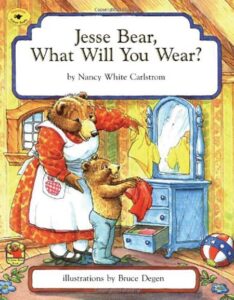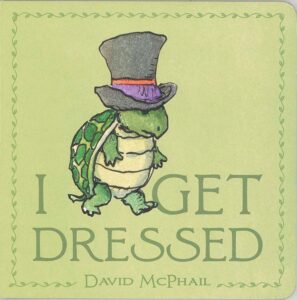Fine motor development, Good health practices
A toddler participates in a brief book sharing and plays alongside a caregiver to put felt clothing items on a teddy bear cutout on a flannel board.


Clothes

Be Prepared: Use the provided cutout patterns to make two bears and two sets of clothing (three clothing items each) for you and a toddler to manipulate. Use a permanent marker to add details, such as eyes and nose, to the bear’s cutout. Use different colors of felt, if possible. The felt board should be large enough for you and a toddler to work simultaneously on two bear cutouts affixed to the board. Form two collections of the three items of clothing, one for the toddler and one for you.
 Invite a toddler to look at pictures in the Jesse Bear book with you. Point to (or ask the toddler to point to) and talk about pieces of clothing illustrated in the book. Then invite the toddler to play next to you in putting clothes on a teddy bear. Give the toddler a teddy bear felt cutout and help him/her place it on the felt board. Put your teddy bear felt cutout next to the toddler’s, with sufficient space for you to work alongside the toddler.
Invite a toddler to look at pictures in the Jesse Bear book with you. Point to (or ask the toddler to point to) and talk about pieces of clothing illustrated in the book. Then invite the toddler to play next to you in putting clothes on a teddy bear. Give the toddler a teddy bear felt cutout and help him/her place it on the felt board. Put your teddy bear felt cutout next to the toddler’s, with sufficient space for you to work alongside the toddler.
Give the toddler one of the small collections of felt pieces of clothing (three items) to put on the bear. Point to and describe each piece of clothing. Invite the toddler to say or point to where the clothing should go on the felt teddy bear. Ask and talk about which item(s) should go on first. Talk about how it is hard to put on our pants if we are wearing our shoes. Then encourage the toddler to put the clothes on the teddy bear. Put your set of felt clothing on your teddy bear, so the two of you are engaged in parallel work with the felt pieces. Encourage the toddler to talk about what clothes he/she is putting on the teddy bear.
Emphasize that we are using our hands to put the felt pieces on the board.
Notice how the toddler uses his/her hand(s), especially fingers, to hold and place felt pieces on the flannel board. Provide verbal support or, if necessary, direct assistance in placement of clothing items. Spatial skills are directly involved in aligning a clothing item with a part of the bear’s body. If the clothing item is misaligned, encourage the toddler to try putting a clothing item in different locations on the desired spot, like putting together pieces of a puzzle. Another strategy is to talk about a specific part of the clothing, such as the waist of the pants, and ask where the waist goes when he/she wears pants. It is not necessary or appropriate to expect perfect images of a dressed bear.
The activity supports a toddler’s understanding of where clothes are worn on a body and, in a minor way, a general order in which we put on clothes (specifically, put on shoes last). If a toddler places an item in an unusual location on the bear, such as pants on the head of the bear, determine whether the toddler is being silly. If silliness is not a factor, talk with the toddler about where he/she wears his/her pants, for example, and ask how the bear might feel or do things while having pants in an unusual location.
Extra support
Enrichment
Fine motor development, Good health practices
Toddlers put a shirt and hat on a baby doll and participate in a discussion of head, arms, and why we wear a hat.




Be Prepared: Newborn-size shirts are suggested because toddlers can put them on dolls and remove them without difficulty. Arrange dolls and clothes in the dramatic play center, or another area if the dramatic play center is already in use. If you are using dolls that are new to toddlers in your room, introduce the dolls to your toddler group at least one week before the activity.
[Invite several toddlers to the dramatic play area to play with dolls. Sit on the floor facing the toddlers. Encourage the toddlers to help you to take care of the baby dolls. Give each toddler a doll. Display clothing items as you describe each below.]
We have some clothes we can put on our baby dolls. Here is a shirt for the baby to wear. Here is a hat for the baby doll to wear.
Let’s begin with a shirt. Each of us can put a shirt on our doll.
[Give each toddler one shirt for his/her doll. Hold and describe a shirt against your doll as a reminder of where the shirt goes.
Demonstrate putting a shirt over a doll’s head and putting the doll’s arms into the shirt. Emphasize the names of the doll’s body parts in your description, especially head and arms. Invite toddlers to point to the head and arms of their baby doll. Encourage toddlers to follow your actions. Provide verbal support or hands-on assistance as appropriate.
Repeat and extend toddlers’ comments. Positively acknowledge toddlers’ efforts. Example: “You are working so hard! You are getting the shirt on your baby doll.”]
Do you want to put a hat on the head of your baby doll?
[Give a hat to each toddler who wishes to put a hat on his/her doll. Demonstrate putting a hat on a doll’s head, if necessary.]
 [Talk briefly with toddlers about why we sometimes wear a hat: to keep the sun off our head, to keep our head warm when it is cold outside, to keep our head dry when it is raining outside.]
[Talk briefly with toddlers about why we sometimes wear a hat: to keep the sun off our head, to keep our head warm when it is cold outside, to keep our head dry when it is raining outside.]
[Display the cover of the I Get Dressed book.]
We have a book about getting dressed. This is a silly book! Let’s look at the pictures in this book. You may hold your baby doll so you can look at the pictures with me.
[Use your own words to talk about book illustrations. The book has few printed words. Encourage toddlers to point to items of clothing or body parts, such as a bunny wearing shoes!
Pace book sharing in relation to toddlers’ interests. Share the toddlers’ enjoyment at the humor of pictures.]
It can be hard to put a shirt on a baby! We put a shirt over the doll’s head. We put the doll’s arms through the shirt. We talked about why we wear a hat. We looked at a silly book about getting dressed!
Toddlers may find it challenging to put a shirt on a baby doll. Look for ways you can provide verbal or hands-on assistance without taking over the dressing process. Generally, toddlers learn to take doll clothes off before they are able to put them back on. This activity supports toddlers’ understanding of self-dressing concepts (such as a shirt goes over the head before arms go into sleeves). Dressing dolls fosters fine motor skills toddlers will use when they begin to dress and undress themselves. The activity provides an opportunity to talk with toddlers about dressing themselves.
Extra support
Enrichment
Fine motor development
Toddlers participate in pretend play that emphasizes putting clothes on toy dolls.

Toy dolls and clothes

Getting dressed

Be Prepared: Make sure the dramatic play area has an adequate supply of baby dolls and clothing for toddlers to put on the dolls.
Sit on the floor with toddlers in the dramatic play area to facilitate individual and shared toddler activity focused on helping toy dolls get dressed. Encourage toddlers to dress the dolls or take off existing clothes so a different set of clothing may be put on a doll. The intent is to support toddlers’ use of fine motor skills in putting on and removing clothes from dolls. Provide verbal or hands-on assistance with fine motor efforts, where appropriate. Help toddlers take turns with dressing the dolls if there is an insufficient supply for each toddler to have his/her own doll and set of clothes. Encourage toddlers to talk about the clothes they are putting on or taking off the doll, and how they are putting on/taking off the clothes. In addition to manipulating dolls and clothing, toddlers will enjoy using props associated with babies, such as small containers that can represent food and toy bottles. At this age, toddlers are not expected to tie shoelaces.
Your presence in this activity is essential to guided play. A toddler may avoid a challenging fine motor action involved in dressing a doll without your encouragement and assistance. You may wish to demonstrate some parts of dressing a doll, which is generally more difficult for toddlers than undressing a doll. Encourage toddlers to work with more unusual items on clothing, such as large buttons, or a hook and loop closure.
Many toddlers enjoy enacting family routines, such as meals and bedtime. Provide spaces for toddlers to put dolls and animals to sleep. Toddlers may come and go from the informal gathering.
Extra support
Enrichment
Materials Needed: Gather available books about getting dressed, such as the following: I Get Dressed by David McPhail; Froggy Gets Dressed by Jonathan London; Jesse Bear, What Will You Wear? by Nancy White Carlstrom; Oliver West! It’s Time to Get Dressed by Kelly Louise (author) and Rebecca Sinclair (illustrator); and Getting Dressed with Lily and Milo by Pauline Oud; paintbrushes; paint; play dough; manipulative toys; pegboards; button box; props like dolls and doll clothing, dress up clothes, bags, and purses; felt bear and its clothes
Arrange books so toddlers can see different kinds of clothing and ways to get dressed. Providing medium-size paintbrushes with washable paint, play dough, and manipulative toys that fit together, are good ways to support fine motor skills. Arrange props in a dramatic play center to encourage further play with dolls and doll clothes (promoted in Option 3). Include easy-to-use dress up clothes, such as vests, shirts, skirts with elastic waistbands. Toddlers will enjoy various bags and purses to carry. Put the felt bear and clothes (Option 1) near the flannel board for toddlers to explore. Draw the bear shape on easel paper and encourage toddlers to paint clothes on the bear.
Materials Needed: baby dolls and soft animals with clothing, silky scarves, stacking ring, paper plates, hole punch, shoelace, cardstock, clothing
Dress baby dolls and soft animals. Help toddlers and mobile infants remove items of clothing, such as the doll hat, doll shirt, and pants. Provide silky scarves and demonstrate how to wrap the scarf around a doll or a stacking ring. Punch holes in paper plates and encourage preschool-age children to lace a shoelace or thick string through the holes. School-age children may enjoy punching their own design in cardstock to lace. Encourage preschool-age children and older children to assist toddlers with outdoor clothing.
If you live in a cold climate, talk with toddlers and preschool-age children about the order in which we prepare to go outside. Example: use bathroom first, wash hands, then put on snow pants, boots, and coat. Mittens go last. You might want to encourage older children to help you make a simple chart that shows the order.